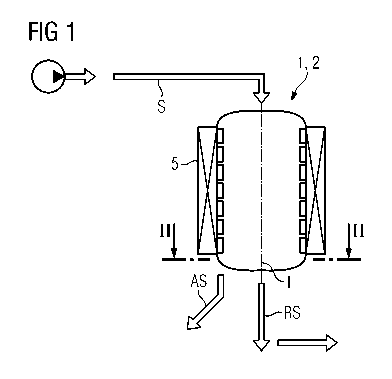Some of the information on this Web page has been provided by external sources. The Government of Canada is not responsible for the accuracy, reliability or currency of the information supplied by external sources. Users wishing to rely upon this information should consult directly with the source of the information. Content provided by external sources is not subject to official languages, privacy and accessibility requirements.
Any discrepancies in the text and image of the Claims and Abstract are due to differing posting times. Text of the Claims and Abstract are posted:
| (12) Patent Application: | (11) CA 2769502 |
|---|---|
| (54) English Title: | METHOD FOR SEPARATING MAGNETIZABLE PARTICLES FROM A SUSPENSION AND ASSOCIATED DEVICE |
| (54) French Title: | PROCEDE DE SEPARATION DES PARTICULES MAGNETISABLES D?UNE SUSPENSION ET DISPOSITIF ASSOCIE |
| Status: | Deemed Abandoned and Beyond the Period of Reinstatement - Pending Response to Notice of Disregarded Communication |
| (51) International Patent Classification (IPC): |
|
|---|---|
| (72) Inventors : |
|
| (73) Owners : |
|
| (71) Applicants : |
|
| (74) Agent: | SMART & BIGGAR LP |
| (74) Associate agent: | |
| (45) Issued: | |
| (86) PCT Filing Date: | 2010-07-23 |
| (87) Open to Public Inspection: | 2011-02-03 |
| Examination requested: | 2015-03-17 |
| Availability of licence: | N/A |
| Dedicated to the Public: | N/A |
| (25) Language of filing: | English |
| Patent Cooperation Treaty (PCT): | Yes |
|---|---|
| (86) PCT Filing Number: | PCT/EP2010/060683 |
| (87) International Publication Number: | WO 2011012539 |
| (85) National Entry: | 2012-01-27 |
| (30) Application Priority Data: | ||||||
|---|---|---|---|---|---|---|
|
In a method for separating magnetisable particles from a suspension, the suspension is passed through a cylinder-symmetrical separator wherein the substance streams are separated by means of at least one tubular separation screen. According to the invention, the separator separates the substance stream into a concentrate as well as a so-called tailing and the control of the separation rate of the concentrate and tailing is carried out solely by controlling the flow rate. To this end, at least one separation screen (11, 21) is displaceable in the separator (10, 20), so that a variable gap (15, 25) is formed.
L?invention concerne un procédé de séparation des particules magnétisables d?une suspension, la suspension étant transportée à travers un séparateur cylindrosymétrique dans lequel a lieu une séparation des flux de matières par l?intermédiaire d?un écran de séparation au moins de forme tubulaire. Selon l?invention, le flux de matières, en passant dans le séparateur, est séparé en un concentré d?une part et en un résidu (gangue) d?autre part, le taux de séparation concentré/résidu n?étant influencé que par le débit. En outre, au moins un écran de séparation (11, 12) est mobile dans le séparateur (10, 20), de telle sorte qu?une fente variable (15, 25) soit formée.
Note: Claims are shown in the official language in which they were submitted.
Note: Descriptions are shown in the official language in which they were submitted.

2024-08-01:As part of the Next Generation Patents (NGP) transition, the Canadian Patents Database (CPD) now contains a more detailed Event History, which replicates the Event Log of our new back-office solution.
Please note that "Inactive:" events refers to events no longer in use in our new back-office solution.
For a clearer understanding of the status of the application/patent presented on this page, the site Disclaimer , as well as the definitions for Patent , Event History , Maintenance Fee and Payment History should be consulted.
| Description | Date |
|---|---|
| Time Limit for Reversal Expired | 2017-07-25 |
| Application Not Reinstated by Deadline | 2017-07-25 |
| Inactive: Abandoned - No reply to s.30(2) Rules requisition | 2016-09-23 |
| Deemed Abandoned - Failure to Respond to Maintenance Fee Notice | 2016-07-25 |
| Inactive: S.30(2) Rules - Examiner requisition | 2016-03-23 |
| Inactive: Report - No QC | 2016-03-21 |
| Letter Sent | 2015-03-27 |
| Request for Examination Received | 2015-03-17 |
| All Requirements for Examination Determined Compliant | 2015-03-17 |
| Request for Examination Requirements Determined Compliant | 2015-03-17 |
| Change of Address or Method of Correspondence Request Received | 2015-01-15 |
| Amendment Received - Voluntary Amendment | 2014-04-07 |
| Inactive: Cover page published | 2012-04-04 |
| Inactive: Notice - National entry - No RFE | 2012-03-13 |
| Inactive: IPC assigned | 2012-03-09 |
| Application Received - PCT | 2012-03-09 |
| Inactive: IPC assigned | 2012-03-09 |
| Inactive: First IPC assigned | 2012-03-09 |
| National Entry Requirements Determined Compliant | 2012-01-27 |
| Application Published (Open to Public Inspection) | 2011-02-03 |
| Abandonment Date | Reason | Reinstatement Date |
|---|---|---|
| 2016-07-25 |
The last payment was received on 2015-06-05
Note : If the full payment has not been received on or before the date indicated, a further fee may be required which may be one of the following
Please refer to the CIPO Patent Fees web page to see all current fee amounts.
| Fee Type | Anniversary Year | Due Date | Paid Date |
|---|---|---|---|
| Basic national fee - standard | 2012-01-27 | ||
| MF (application, 2nd anniv.) - standard | 02 | 2012-07-23 | 2012-06-06 |
| MF (application, 3rd anniv.) - standard | 03 | 2013-07-23 | 2013-06-07 |
| MF (application, 4th anniv.) - standard | 04 | 2014-07-23 | 2014-06-23 |
| Request for examination - standard | 2015-03-17 | ||
| MF (application, 5th anniv.) - standard | 05 | 2015-07-23 | 2015-06-05 |
Note: Records showing the ownership history in alphabetical order.
| Current Owners on Record |
|---|
| BASF SE |
| SIEMENS AKTIENGESELLSCHAFT |
| Past Owners on Record |
|---|
| WERNER HARTMANN |
| WOLFGANG KRIEGLSTEIN |